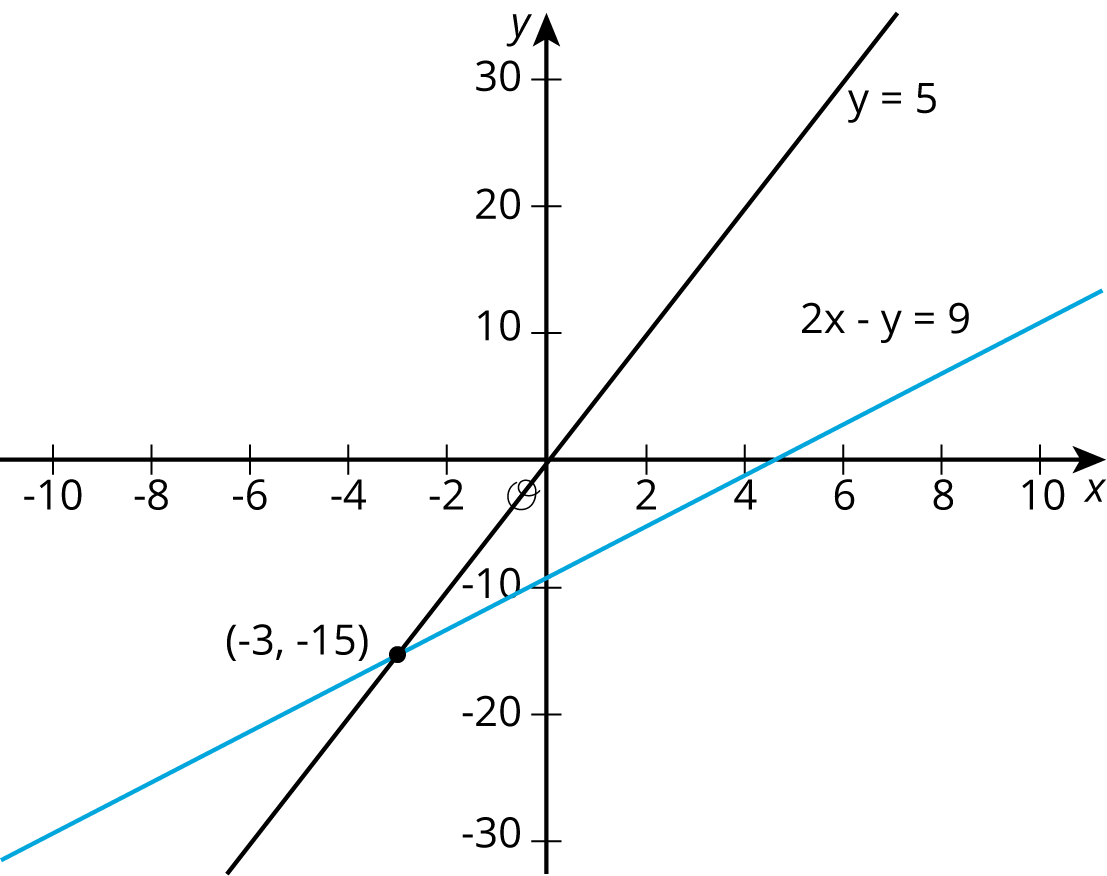14.1: Algebra Talk: Solving Systems Mentally
Solve these without writing anything down:
\begin{cases} x=5\\ y=x-7 \end{cases}
\begin{cases} y=4\\ y=x+3 \end{cases}
\begin{cases} x=8\\ y=\text-11 \end{cases}
Let’s solve systems of equations.
Solve these without writing anything down:
\begin{cases} x=5\\ y=x-7 \end{cases}
\begin{cases} y=4\\ y=x+3 \end{cases}
\begin{cases} x=8\\ y=\text-11 \end{cases}
Here are a lot of systems of equations:
A \begin{cases} y= 4 \\ x=\text-5y+6 \end{cases}
B \begin{cases} y= 7 \\ x=3y-4 \end{cases}
C \begin{cases} y= \frac{3}{2}x+7 \\ x=\text-4 \end{cases}
D \begin{cases} y= \text-3x+10 \\ y=\text-2x+6 \end{cases}
E \begin{cases} y= \text-3x-5 \\ y=4x+30 \end{cases}
F \begin{cases} y= 3x-2 \\ y=\text-2x+8 \end{cases}
G \begin{cases} y= 3x \\ x=\text-2y+56 \end{cases}
H \begin{cases} x=2y-15 \\ y= \text-2x \end{cases}
I \begin{cases} 3x+4y=10 \\ x=2y \end{cases}
J \begin{cases} y= 3x+2 \\ 2x+y = 47 \end{cases}
K \begin{cases} y= \text-2x+5 \\ 2x+3y = 31 \end{cases}
L \begin{cases} x+y=10 \\ x=2y +1 \end{cases}
Tyler was looking at this system of equations:
\begin{cases} x + y = 5\\x + y = 7 \end{cases}
He said,
“Just looking at the system, I can see it has no solution. If you add two numbers, that sum can’t be equal to two different numbers.”
Do you agree with Tyler?
In rectangle ABCD, side AB is 8 centimeters and side BC is 6 centimeters. F is a point on BC and E is a point on AB. The area of triangle DFC is 20 square centimeters, and the area of triangle DEF is 16 square centimeters. What is the area of triangle AED?
When we have a system of linear equations where one of the equations is of the form y = \text{[stuff]} or x=\text{[stuff]}, we can solve it algebraically by using a technique called substitution. The basic idea is to replace a variable with an expression it is equal to (so the expression is like a substitute for the variable). For example, let's start with the system:
\begin{cases} y = 5x\\2x - y = 9 \end{cases}
Since we know that y = 5x, we can substitute 5x for y in the equation 2x - y = 9,
2x - (5x) = 9,
and then solve the equation for x,
We can find y using either equation. Using the first one: y = 5 \boldcdot \text-3. So
(\text-3,\text -15)
is the solution to this system. We can verify this by looking at the graphs of the equations in the system:

Sure enough! They intersect at (\text-3, \text-15).
We didn't know it at the time, but we were actually using substitution in the last lesson as well. In that lesson, we looked at the system
\begin{cases} y = 2x + 6 \\ y = \text-3x - 4 \end{cases}
and we substituted 2x+6 for y into the second equation to get 2x+6=\text-3x-4. Go back and check for yourself!